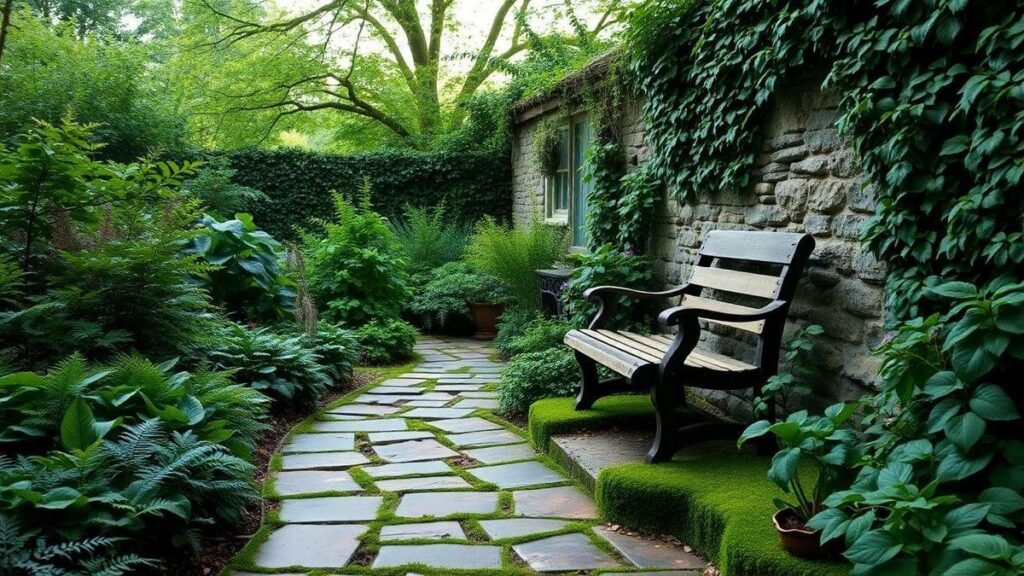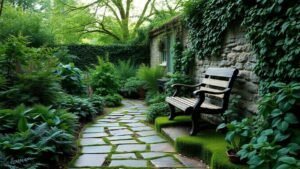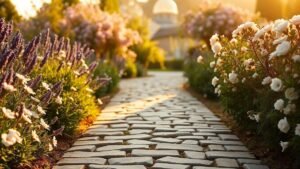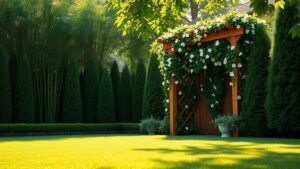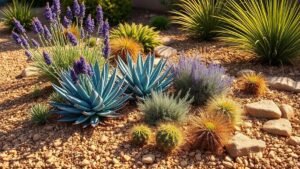Shade Loving Plants for low-light gardens in northern climates
Shade Loving Plants for low-light gardens in northern climates are my happy obsession and my secret plan for yards that seem allergic to sun. I wander the shade like a detective: I read shadows, feel the soil with my boot, and pick tough perennials, hearty ferns, bright bulbs, and low groundcovers that shrug off cold and wet. I want low work, winter structure, and plants deer mostly skip. Below are simple tricks, favorite go-tos, and my muddy-boot wisdom.

Key takeaway
- Plant Hostas and ferns — they excel in low light.
- Add lilies of the valley and early bulbs for spring cheer.
- Use evergreen shrubs for winter shape.
- Add compost and mulch to keep shade soil rich and moist.
- Group plants by moisture needs to avoid drama.
How I choose Shade Loving Plants for low-light gardens in northern climates
I pick plants by hardiness, shade tolerance, and whether they laugh at cold, wet feet. Look for labels rated for USDA zones 3–5 and for partial to full shade. Test soil with a shovel: if it stays soggy after rain, choose species that like wet ground. Favor plants with winter interest so beds don’t nap through February — and review tips on preparing beds for winter when you’re planning now.
Shade-tolerant perennials I rely on
I stick to perennials that come back without drama. When shopping, I look for hardiness, moisture needs, and standout foliage or bloom. For deeper lists and selection tips, I often consult a guide to perennials for shady sites.
| Plant | Hardiness (zones) | Soil & moisture | Quick notes |
|---|---|---|---|
| Hosta | 3–8 | Moist, rich | Big leaves, excellent shade performer. Deer nibble sometimes. |
| Astilbe | 4–8 | Moist to wet | Feathery plumes; loves damp shade. |
| Heuchera (coral bells) | 4–9 | Well-drained, moist | Bold foliage color; low care. |
| Brunnera macrophylla | 3–8 | Moist, humusy | Heart-shaped leaves; tiny blue spring flowers. |
| Pulmonaria (lungwort) | 3–8 | Moist, acidic | Early flowers; spotted leaves; great groundcover. |
I plant Hostas in clumps, use Astilbe in rainier pockets, and space Heuchera so its foliage can shine.
Shade-loving ferns that handle cold and wet
Ferns are wet-shade heroes. They bounce back and make damp corners look like a woodland — see examples in a roundup of shade-tolerant plants that brighten tree understories.
| Fern | Hardiness (zones) | Wet soil tolerance | Quick notes |
|---|---|---|---|
| Matteuccia struthiopteris (ostrich fern) | 2–7 | Loves wet | Big arching fronds — perfect near water. |
| Osmunda regalis (royal fern) | 3–9 | Likes wet | Tall, dramatic; tolerates heavy soil. |
| Athyrium filix-femina (lady fern) | 3–8 | Moist | Airy texture; cold-hardy. |
| Dryopteris marginalis (marginal wood fern) | 3–8 | Moderate | Evergreen-like habit in mild winters. |
| Polystichum acrostichoides (Christmas fern) | 3–8 | Moderate to dry | Stays green; great on slopes and under trees. |
I tuck ostrich ferns into my rain garden and rely on Christmas ferns for winter shape.
Tips on cold-hardy shade planting (short list)
- Always check the hardiness zone on the tag.
- Pick plants with known wet-soil tolerance for low spots — read about drainage and watering best practices in a practical guide to preventing over- and underwatering.
- Add organic mulch to reduce freeze-thaw heaving and boost roots with advice from the compost and soil-amendment guides.
- Use layering: groundcover, mid-height perennials, and ferns for depth.
- Plant in early fall or early spring when soil is workable — see tips on preparing for spring planting.
- Divide crowded clumps every few years.
How I read shade and soil to pick the best plants
I treat each spot like a small experiment. Walk, watch, poke the dirt — then decide.
Measuring low-light spots
- Stick test: mark a stake hourly. Less than 3 hours direct sun = full shade.
- Book test: can I read a paperback at noon? If yes, it’s not deep shade.
- Phone apps help, but my stick is free. If you need more light in a tight spot, consider tricks like using reflective surfaces to boost light.
| Observation | What I call it | Plants that like it |
|---|---|---|
| < 3 hours direct sun | Full shade | Ferns, Hostas, Pulmonaria |
| 3–6 hours | Part shade | Heuchera, Astilbe, Brunnera |
| > 6 hours | Not shade | Pick sun lovers |
Soil, drainage, and pH (quick checks)
- Drainage test: dig 12″, fill with water — drains within 4–6 hours = OK.
- Texture: crumbly = loam, sticky = clay, gritty = sand.
- pH: most shade lovers like slightly acid to neutral soil.
| Problem | Quick fix |
|---|---|
| Heavy clay | Add compost and coarse sand; or raise the bed |
| Very sandy | Add compost and organic matter |
| Poor drainage | Add organic matter, raise beds, or add gravel layer |
| Alkaline pH | Add peat moss/acidic compost or choose tolerant plants |
Always add compost and organic amendments — they feed roots, improve drainage, and stabilize soil through winter. Mulch 2–3 inches to keep roots warm and moist.

My go-to groundcovers and spring bulbs
I love low-work plants that naturalize. These are my reliable picks for Shade Loving Plants for low-light gardens in northern climates — and you can find curated lists of low-light performers in a roundup of best plants for low-light gardens.
Low-maintenance groundcovers
| Plant | Light | Soil | Why I like it |
|---|---|---|---|
| Vinca minor (periwinkle) | Deep shade–part shade | Moist, well-drained | Fast cover; glossy leaves; spring flowers |
| Pachysandra | Deep shade | Rich, moist | Evergreen carpet; low care |
| Ajuga (bugleweed) | Part shade | Average to moist | Bold foliage and spring spikes |
| Sweet woodruff (Galium odoratum) | Shade | Moist, humusy | Fragrant, delicate flowers under trees |
| Heuchera (spreading types) | Part shade | Well-drained | Colorful foliage for contrast |
Plant in drifts: one pot becomes a small colony in two seasons.
Spring bulbs that perform in shade
Bulbs that bloom before trees leaf out give big payoff.
| Bulb | Bloom time | Best spot | Notes |
|---|---|---|---|
| Galanthus (snowdrop) | Very early spring | Deep–part shade | Tough, naturalizes well |
| Crocus | Early spring | Part shade | Great in grass or among groundcover |
| Scilla siberica (Siberian squill) | Early–mid spring | Part shade | Intense blue carpet |
| Leucojum (spring snowflake) | Mid spring | Part shade | Likes damp spots |
| Dwarf daffodils | Early–mid spring | Part shade | Some varieties handle shade and deter deer |
Plant bulbs in groups of 20 for best effect.
Native shade plants to thicken the floor
I favor natives for resilience and pollinators — see more on choosing native plants that support local wildlife and how to create a wildlife-friendly garden.
| Native | Native to | Use | Why I recommend |
|---|---|---|---|
| Asarum canadense (wild ginger) | Eastern N. America | Dense cover | Heart-shaped leaves; long-lived |
| Tiarella cordifolia (foamflower) | Eastern N. America | Textural contrast | Lacy flowers; pairs well with ferns |
| Viola spp. (native violets) | Widespread | Naturalize | Early flowers for pollinators |
| Cornus canadensis (bunchberry) | Northern forests | Low mat | Spring flowers and red fall berries |
Mix natives with non-natives for a natural, layered floor that needs less fuss.
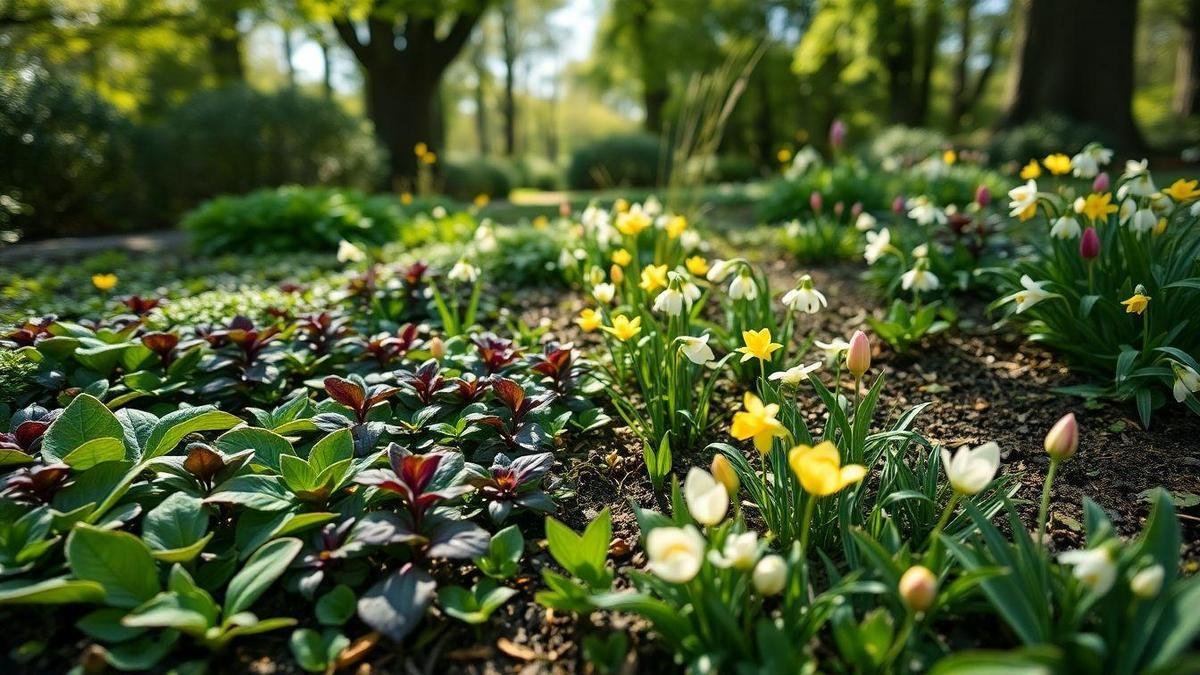
Evergreens and winter interest
Winter is long. Evergreens give color, form, and backbone when deciduous plants nap. For Shade Loving Plants for low-light gardens in northern climates, I plant evergreens that tolerate shade and cold — and plan planting and protection around the ideas in cold-weather garden care.
Cold-hardy shrubs that keep shape under snow
| Plant | Type | Why I pick it |
|---|---|---|
| Boxwood (Buxus) | Evergreen shrub | Neat shape; tolerates deep shade |
| Yew (Taxus) | Evergreen shrub | Very cold-hardy; prunes well |
| Japanese holly (Ilex crenata) | Evergreen shrub | Small leaves; tidy habit |
| Rhododendron (evergreen) | Evergreen shrub | Shiny leaves and spring flowers |
| Bergenia | Evergreen perennial | Big leaves that hold through snow |
I often test shrubs in pots for a season before planting.
Year-round structure
Plants that matter in January make the garden readable in winter:
- Boxwood — slow topiary lines.
- Yew — a green signpost in snow.
- Japanese holly — tidy low hedges.
- Rhododendron — holds foliage better than many broadleaf evergreens.
Plant in odd-numbered groups for a casual but calculated look.

How I layer shade-tolerant perennials for color and texture
Think of a shady bed as a three-layer cake: groundcover (low), perennials and ferns (middle), and evergreen structure (back). I choose Shade Loving Plants for low-light gardens in northern climates that tolerate cold and low sun. For low-maintenance perennial combinations, see suggestions in a guide to perennials for low-maintenance gardens.
Ferns as the soft middle layer
| Fern | Light | Height | Why I use it |
|---|---|---|---|
| Japanese painted fern (Athyrium) | Deep shade–part sun | 12–18 in | Silver fronds add subtle color |
| Male fern (Dryopteris) | Shade | 18–36 in | Tough, evergreen-like habit |
| Ostrich fern (Matteuccia) | Moist shade | 24–48 in | Big, dramatic fronds for the back |
Ferns hide tired stems and give gentle movement.
Foliage contrast tricks
Pair large, bold leaves with fine, lacy ones. Use variegation and bright leaf color to break up green.
| Plant | Leaf look | Mix with | Tip |
|---|---|---|---|
| Hosta | Large, smooth | Ferns, Heuchera | Variegated types brighten shade |
| Heuchera | Colorful, ruffled | Hosta | Reds and purples add contrast |
| Tiarella | Lace-like | Hosta | Spring blooms plus texture |
A lime Hosta next to dark Heuchera reads like neon next to chocolate — striking without fuss.
Low-work care: mulch, water, deer
I choose plants that do the job with little fuss and follow simple routines.
| Problem | My go-to fix |
|---|---|
| Dry soil | Deep weekly soak; check with finger — see watering tips at preventing over- and underwatering |
| Weeds | 2–3″ mulch; spot weed early |
| Deer browsing | Deer-tolerant species; physical barrier if needed |
- Mulch: 2–3 inches of organic mulch, gap at stems to prevent rot.
- Water: Deeply once a week in dry spells; shady beds need steady moisture.
- Deer: Plant less-tasty species (ferns, Pulmonaria, Heuchera), add short fencing, or use motion-activated deterrents. For pest and disease solutions, consult practical advice on natural pest controls and handling common plant diseases.
I keep notes on my phone and fix small problems fast.
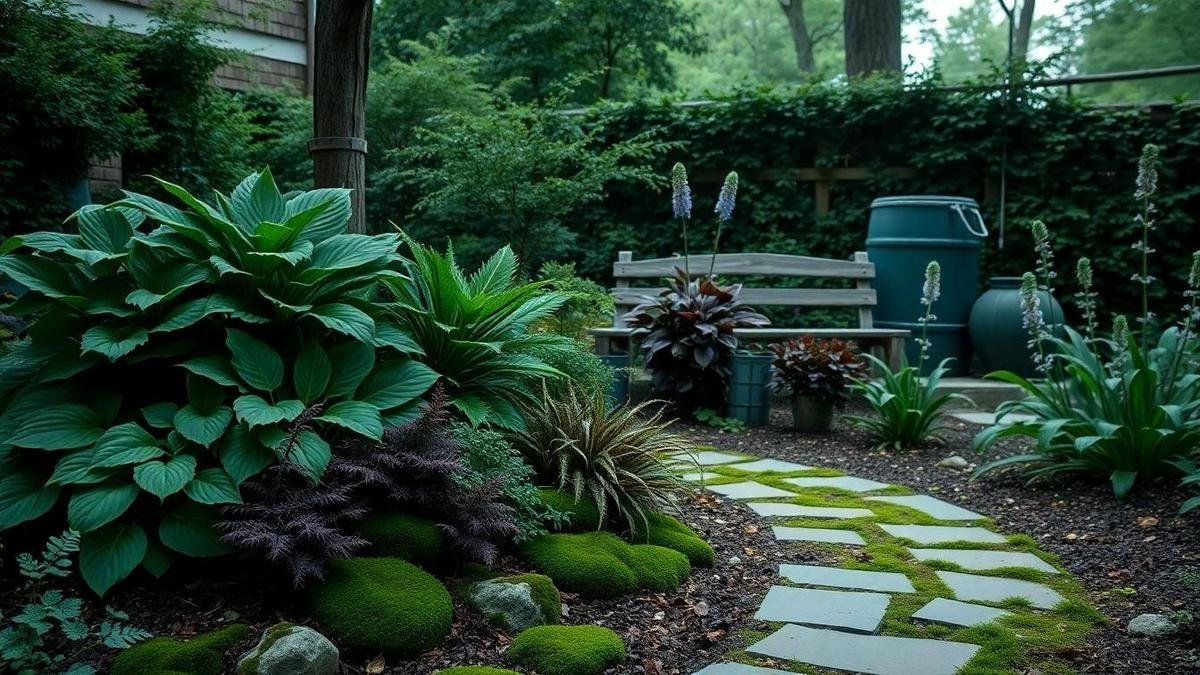
Choosing natives and helping pollinators
Natives survive winter better and help local bees and butterflies. Plant in clumps so pollinators notice — learn more about choosing native pollinator-friendly plants and designing a wildlife-focused yard.
Good natives for shade:
- Aquilegia canadensis (red columbine) — attracts hummingbirds.
- Asarum canadense (wild ginger) — low-maintenance groundcover.
- Trillium — woodland charm (respect local rules).
- Geranium maculatum — nectar for bees.
- Polygonatum (Solomon’s seal) — sturdy, shady.
Conclusion
I’m smitten with shade-loving gardens because they prove life goes on without full sun. Choose tough perennials, bold ferns, surprise-making bulbs, and stubborn groundcovers that laugh at cold and soggy feet. My rule: pick plants rated for USDA zones 3–5, test shade with a stick, and group by moisture so nobody causes plant drama.
A little compost, 2–3 inches of mulch, and smart layering — groundcover, mid-height, and a feathery fern middle — do most of the heavy lifting. Plant for winter structure (boxwood, yew), favor deer-tolerant choices, and tidy small problems early.
Think of your shady bed as a three-layer cake: simple to assemble, rewarding to admire. Want more dirty-boot wisdom and plant lists? See curated picks for the best plants for low-light gardens.
Frequently asked questions
Q: What are the best plants for shade in northern yards?
A: Top picks include Hosta, ferns, Astilbe, Pulmonaria, and Heuchera — all reliable Shade Loving Plants for low-light gardens in northern climates.
Q: How much light counts as “shade”?
A: Less than 3–4 hours of direct sun is generally shade. Dappled sun is a polite nod from the sun.
Q: How do I keep shade plants alive through harsh winters?
A: Mulch in fall, leave some leaf litter for insulation, choose hardy varieties, and avoid dramatic pruning before winter — see more on cold-weather protection.
Q: Can I grow shade plants in pots on my porch?
A: Yes — use a large pot, rich soil, and water more often since containers dry faster; consider ideas from a guide to container plants for small patios.
Q: What pests or problems should I expect in the shade?
A: Slugs, snails, and mildew are common. Use beer traps, copper tape, good airflow, and plant-resistant species. Deer can be a problem — use barriers or deer-tolerant plants and consult natural pest-control options at natural pest solutions.
(Keyword usage note: this article focuses on practical planting and care advice for Shade Loving Plants for low-light gardens in northern climates, with repeated, natural mentions to help with search relevance.)

